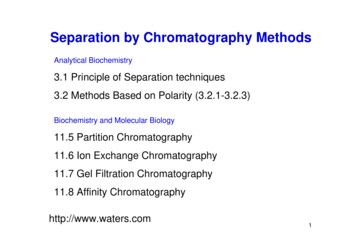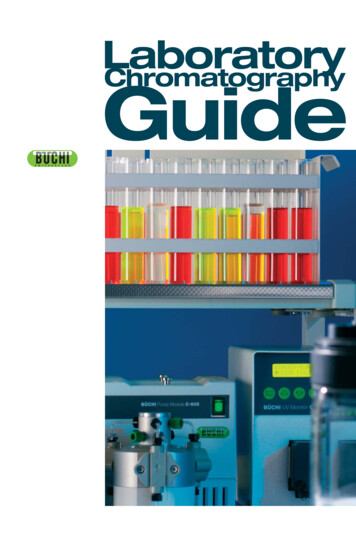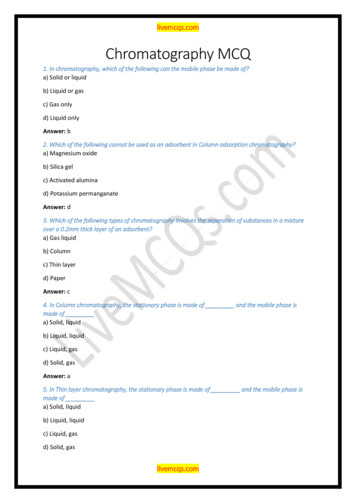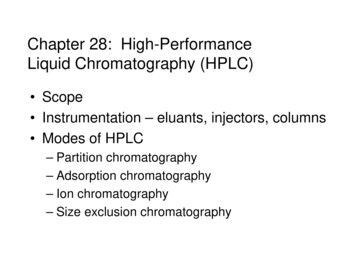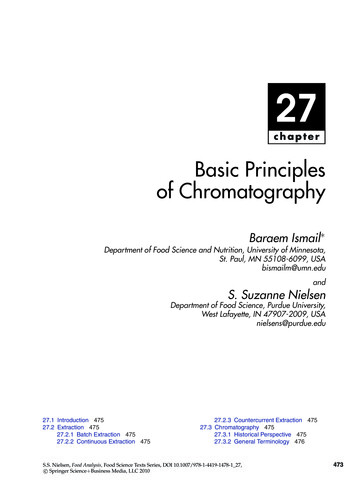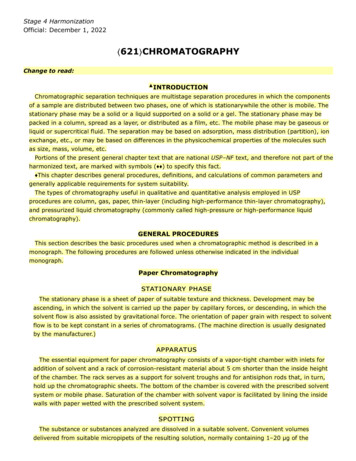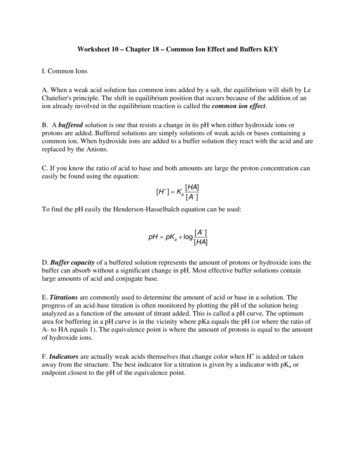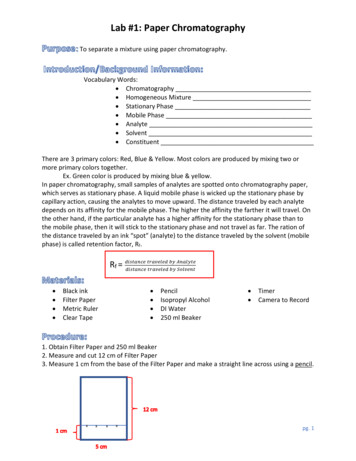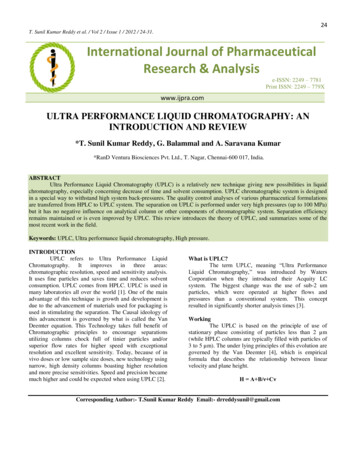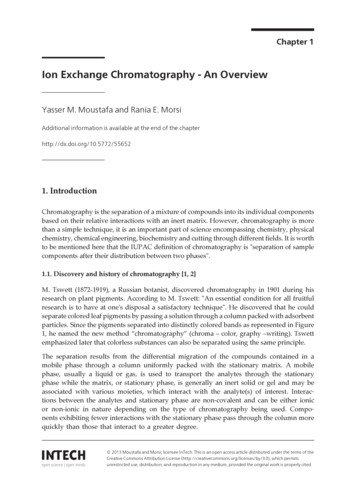
Transcription
Chapter 1Ion Exchange Chromatography - An OverviewYasser M. Moustafa and Rania E. MorsiAdditional information is available at the end of the chapterhttp://dx.doi.org/10.5772/556521. IntroductionChromatography is the separation of a mixture of compounds into its individual componentsbased on their relative interactions with an inert matrix. However, chromatography is morethan a simple technique, it is an important part of science encompassing chemistry, physicalchemistry, chemical engineering, biochemistry and cutting through different fields. It is worthto be mentioned here that the IUPAC definition of chromatography is "separation of samplecomponents after their distribution between two phases".1.1. Discovery and history of chromatography [1, 2]M. Tswett (1872-1919), a Russian botanist, discovered chromatography in 1901 during hisresearch on plant pigments. According to M. Tswett: "An essential condition for all fruitfulresearch is to have at one's disposal a satisfactory technique". He discovered that he couldseparate colored leaf pigments by passing a solution through a column packed with adsorbentparticles. Since the pigments separated into distinctly colored bands as represented in Figure1, he named the new method “chromatography” (chroma – color, graphy –writing). Tswettemphasized later that colorless substances can also be separated using the same principle.The separation results from the differential migration of the compounds contained in amobile phase through a column uniformly packed with the stationary matrix. A mobilephase, usually a liquid or gas, is used to transport the analytes through the stationaryphase while the matrix, or stationary phase, is generally an inert solid or gel and may beassociated with various moieties, which interact with the analyte(s) of interest. Interac‐tions between the analytes and stationary phase are non-covalent and can be either ionicor non-ionic in nature depending on the type of chromatography being used. Compo‐nents exhibiting fewer interactions with the stationary phase pass through the column morequickly than those that interact to a greater degree. 2013 Moustafa and Morsi; licensee InTech. This is an open access article distributed under the terms of theCreative Commons Attribution License (http://creativecommons.org/licenses/by/3.0), which permitsunrestricted use, distribution, and reproduction in any medium, provided the original work is properly cited.
2Column ChromatographyFigure 1. Schematic diagram of the principles of chromatography as discovered by Tswett (1901).Tswett’s initial experiments involved direct visual detection and did not require a meansof quantitation. Nowadays, chromatography is not only a separation technique. In mostversions, it is hyphenated analytical techniques combining the separation with theidentification and quantitative determination of the separated components. In this form,chromatography has become the most widely used technique in the chemical analysis ofcomplex mixtures.Many versions of chromatography are used. The various chromatographic techniques aresubdivided according to the physical state of these two phases, the mobile and thestationary phases. These are: liquid chromatography including high performance, ion,micellar, electrokinetic, thin-layer, gel-permeation, and countercurrent versions; gaschromatography and supercritical fluid chromatography. Various forms of chromatogra‐phy can be used to separate a wide variety of compounds, from single elements to largemolecular complexes. By altering the qualities of the stationary phase and/or the mobilephase, it is possible to separate compounds based on various physiochemical characteris‐tics. Among these characteristics are size, polarity, ionic strength, and affinity to othercompounds. Chromatography also permits a great flexibility in the technique itself. Theflow of the mobile phase might be controlled by gravity, pressure, capillary action andelectro-osmosis; the separation may be carried out over a wide temperature range andsample size can vary from a few atoms to many kilograms. Also, the shape of the systemin which the separation takes place can be varied, using columns of various length anddiameter or flat plates. Through all this, evaluation chromatography has been trans‐formed from an essentially batch technique into an automated instrumental method.Through its continuous growth, chromatography became the most widely used analyticalseparation technique in chemistry and biochemistry. Thus, it is not exaggeration to call itthe technique of the 20th Century.
Ion Exchange Chromatography - An Overviewhttp://dx.doi.org/10.5772/556522. Ion chromatographyClassical liquid chromatography based on adsorption- desorption was essentially a non-linearprocess where the time of retardation (retention time) and the quantitative response dependon the position on the adsorption isotherm. Essentially, it was a preparative technique: the aimwas to obtain the components present in the sample in pure form which could then besubmitted to further chemical or physical manipulations [3].Ion exchange chromatography (or ion chromatography, IC) is a subset of liquid chromatog‐raphy which is a process that allows the separation of ions and polar molecules based on theircharge. Similar to liquid chromatography, ion chromatography utilizes a liquid mobile phase,a separation column and a detector to measure the species eluted from the column. Ionexchange chromatography can be applied to the determination of ionic solutes, such asinorganic anions, cations, transition metals, and low molecular weight organic acids and bases.It can also be used for almost all kinds of charged molecule including large proteins, smallnucleotides and amino acids. The IC technique is frequently used for the identification andquantification of ions in various matrices.2.1. Ion chromatography process [4]The basic process of chromatography using ion exchange can be represented in 5 steps (as‐suming a sample contains two analytes A & B): eluent loading, sample injection, separationof sample, elution of analyte A, and elution of analyte B, shown and explained below. Elu‐tion is the process where the compound of interest is moved through the column. This hap‐pens because the eluent, the solution used as the solvent in chromatography, is constantlypumped through the column. The representative schemes below are for an anion exchangeprocess. (Eluent ion , Ion A , Ion B )Step 1: The eluent loaded onto the column displaces any anions bonded to the resin andsaturates the resin surface with the eluent anion.This process of the eluent ion (E-) displacing an anion (X-) bonded to the resin can be expressedby the following chemical interaction:Resin -X- E- Resin -E- XStep 2: A sample containing anion A and anion B are injected onto the column. This samplecould contain many different ions, but for simplicity this example uses just two different ionsas analytes in the sample.3
4Column ChromatographyStep 3: After the sample has been injected, the continued addition of eluent causes a flowthrough the column. As the sample elutes (or moves through the column), anion A and anionB adhere to the column surface differently. The sample zones move through the column aseluent gradually displaces the analytes.Step 4: As the eluent continues to be added, the anion A moves through the column in a bandand ultimately is eluted first.This process can be represented by the chemical interaction showing the displacement of thebound anion (A ) by the eluent anion (E ).Resin -A E Resin - E A Step 5: The eluent displaces anion B, and anion B is eluted off the column.Resin -B- E- Resin -E- BThe overall 5 step process can be represented pictorially as shown in Figure 2:
Ion Exchange Chromatography - An Overviewhttp://dx.doi.org/10.5772/55652Figure 2. Schematic representation of IC process.A typical ion chromatography consists of several components as shown in Figure 3. The eluentis delivered to the system using a high-pressure pump. The sample is introduced then flowsthrough the guard and into the analytical ion-exchange columns where the ion-exchangeseparation occurs. After separation, the suppressor reduces the conductivity of the eluent andincreases the conductivity of the analytes so they are delivered to the detector. A computerand software are used to control the system, acquire and process the data. Since the introduc‐tion of ion chromatography in 1975, many developments were carried out to improve sup‐pressor technology to provide better sensitivity and consistency for the analysis of a widevariety of compounds [5].Figure 3. Schematic representation of Ion chromatography instrumentation.3. Instrumentation [6-9]Typical IC instrumentation includes: pump, injector, column, suppressor, detector andrecorder or data system as represented in Figure 4.5
6Column ChromatographyFigure 4. Typical ion chromatography instrument.3.1. PumpThe IC pump is considered to be one of the most important components in the system whichhas to provide a continuous constant flow of the eluent through the IC injector, column, anddetector. The most practical system for the delivery of the mobile phase is that which cancombine several liquids in different proportions at the command of the operator. This blendingcapability speeds the process of selecting the optimum eluent mixture required for isocraticanalysis. There is a series of mobile phase reservoirs that can contain a range of different mobilephases that can be used individually, blended or for mobile phase programming purposes"gradient elution". In general liquid chromatography, the reservoirs can be stainless steel butin ion chromatography where the mobile phases can have extreme pH values, the reservoirsneed to be made of glass or preferably a suitable plastic such as PEEK (polyether-ether-ketone).The advantage of PEEK is that it is also inert to many organic solvents that may need to beused in the mobile phase. In fact, all components of an ion chromatograph that may come incontact with either phase of the distribution system should be constructed from appropriateinert material. This includes all mobile phase conduits, valves, pumps, sampling devices,columns, detector sensor cells, etc. The solvent reservoirs are connected to a solvent selectionvalve and a solvent programmer where a particular solvent or particular solvent program canbe selected. The solvent then passes from the selector/programmer to a high pressure pump.The mobile phase passes from the pump to the sampling device, usually a simple rotatingvalve that on rotation places the sample in line with the mobile flow which then passes ontothe column. The exit flow from the column passes either to an ion suppressor (which will be
Ion Exchange Chromatography - An Overviewhttp://dx.doi.org/10.5772/55652discussed later) or directly to the detector. Gas may come out of the solution at the column exitor in the detector, resulting in sharp spikes. Spikes are created by microscopic bubbles whichchange the nature of the flowing stream making it heterogeneous. The drift may occur as thesemicroscopic bubbles gradually collected and combined in the detector cell. The best resultscan be obtained by applying vacuum to each solvent for about 5 min. with subsequent heliumpurging and storing under helium atmosphere.3.1.1. Pumps typesThe constant-flow pumps is the most widely used in all common IC applications. Flow ratestability is an important pump feature that distinguishes pumps. For size exclusion chroma‐tography, the flow rate has to be extremely stable. External electronic control is a very desirablefeature when automation or electronically controlled gradients are to be run.3.1.2. Constant flow pumpsConstant-flow systems are generally of two basic types: reciprocating piston and positivedisplacement (syringe) pumps. Reciprocating piston pump can maintain a liquid flow forindefinitely long time.3.1.3. Reciprocating piston pumpsThe pumping rate is controlled by piston retracts or by the cam rotating speed. The maindrawback of this type of pump is sinusoidal pressure pulsations which lead to the necessityof using pulse dampers.3.1.4. Dual piston pumpsProvides a constant and almost pulse free flow. Both pump chambers are driven by the samemotor through a common eccentric cam; this common drive allows one piston to pump whilethe other is refilling. As a result, the two flow-profiles overlap each other significantly reducingthe pulsation downstream of the pump; this is visualized below.Its advantages are: unlimited solvent reservoir allowing long-term unattended use; quickchangeover and clean out capability; wide flow rate range (0.01 to 10 ml/min) is providedwithout gear change. While its drawbacks are: incompletely compensated pulsations mightbe observable at high refractive index detector sensitivities, especially at low flow rates; pumpreliability depends on the cleanliness of the mobile phase and continued sealing capability offour check valves on each cycle (e.g. several times per minute).Recent improvements include: A computer-designed camshaft is used to achieve maximumoverlap of pump strokes, resulting in virtually undetectable pulsation or ripple and smallvolume check valves are used to allow the pumps to function reliably at flow rates as low as0.001 ml/min.7
8Column Chromatography3.2. InjectorSample introduction can be accomplished in various ways. The simplest method is to use aninjection valve. In more sophisticated LC, automatic sampling devices are incorporated wheresample introduction is done with the help of auto-samplers and microprocessors.In liquid chromatography, liquid samples may be injected directly and solid samples needonly to be dissolved in an appropriate solvent. The solvent need not to be the mobile phase,but frequently it is judiciously chosen to avoid detector interference, column/componentinterference or loss in efficiency. It is always best to remove particles from the sample byfiltering, or centrifuging since continuous injection of particulate materials will eventuallycause blockage of injection devices or columns.Injectors should provide the possibility of injecting the liquid sample within the range of 0.1to 100 ml of volume with high reproducibility and under high pressure (up to the 4000 psi).They should also produce minimum band broadening and minimize possible flow disturban‐ces. The most useful and widely used sampling device for modern LC is the microsamplinginjector valve. With these sampling valves, samples can be introduced reproducibly intopressurized columns without significant interruption of flow, even at elevated temperatures.With commercially available automatic sampling devices, large numbers of samples can beroutinely analyzed by LC without operator intervention. Such equipment is popular for theanalysis of routine samples (e.g., quality control of drugs), particularly when coupled withautomatic data-handling systems. Automatic injectors are indispensable in unattendedsearching (e.g., overnight) for chromatographic parameters such as solvent selectivity, flowrate, and temperature optimization.Most of the autosamplers have a piston metering syringe type pump to suck the preestablishedsample volume into a line and then transfer it to the relatively large loop ( 100 ml) in a standardsix-port valve. The simplest autosamplers utilize the special vials with pressuarization caps.A special plunger with a needle, push the cap down to the vial and displace the sample throughthe needle into the valve loop. Most of the autosamplers are microprocessor controlled andcan serve as a master controller for the whole instrument3.3. ColumnsThe principle of ion exchange chromatography is that, charged molecules bind electrostaticallyto oppositely charged groups that have been bound covalently on the matrix. Ion exchangechromatography is a type of adsorption chromatography so that, charged molecules adsorbto ion exchangers reversibly so, the molecules can be bounded or eluted by changing the ionicenvironment. Ion exchangers can be used in column chromatography to separate moleculesaccording to charge; actually other features of the molecule are usually important so that thechromatographic behavior is sensitive to the charge density, charge distribution, and the sizeof the molecule. An ion exchanger is usually a three-dimensional network or matrix thatcontains covalently liked charged groups. If a group is negatively charged, it will exchangepositive ions and is a cation exchanger. An example of a group used in cation exchanger is thecarboxy-methyl group. However, if a group is positively charged, it will exchange negative
Ion Exchange Chromatography - An Overviewhttp://dx.doi.org/10.5772/55652ions and is an anion exchanger. An example of a group used in anion exchanger is the di-ethylamino-ethyl group (DEAE). The matrix (stationary phase) can be made of various materials,commonly used materials are dextran, cellulose, and agarose.The separation on an ion exchanger is usually accomplished in two stages: first, the substancesto be separated are bound to the exchanger using conditions that give stable and tight binding;then the column is eluted with buffers of different pH, ionic strength or composition and thecomponents of the buffer compete with the bound material for the binding sites. To choicewhether the ion exchanger is to be anionic or cationic depend on the material to be separated.If the materials to be bound to the column have a single charge (i.e., either plus or minus), thechoice is clear. However, many substances (e.g., proteins), carry both negative and positivecharges and the net charge depends on the pH. In such cases, the primary factor is the stabilityof the substance at various pH values. Most proteins have a pH range of stability (i.e., in whichthey don’t denature) in which they are either positively or negatively charged. So, if a proteinis stable at pH value above the isoelectric point, an anion exchanger should be used; but ifstable at values below the isoelectric point, a cation exchanger is required. Ion exchangecolumns vary widely in size, packing material and material of construction. Depending on itsultimate use and area of application, the column material may be stainless steel, titanium, glassor an inert plastic such as PEEK. The column can vary in diameter from about 2mm to 5 cmand in length from 3 cm to 50 cm depending on whether it is to be used for normal analyticalpurposes, microanalysis, high speed analyses or preparative work. The life of a column willdepend largely on the type of samples it is used to separate but the conditions under whichthe separations are carried out will also place limits on it useful lifetime.Guard column is placed anterior to the separating column. This serves as a protective factorthat prolongs the life and usefulness of the separation column. They are dependable columnsdesigned to filter or remove particles that clog the separation column and compounds and ionsthat could ultimately cause "baseline drift", decreased resolution, decreased sensitivity orcreate false peaks3.4. SuppressorThe suppressor reduces the background conductivity of the chemicals used to elute samplesfrom the ion-exchange column which improves the conductivity measurement of the ionsbeing tested. IC suppressors are membrane-based devices which are designed to convert theionic eluent to water as a means of enhancing the sensitivity. It can be used with universaldetectors to act as a desalting device, thereby removing the interference resulting from thepresence of ionic salts in the eluent. Suppressors are normally used with purely aqueouseluents, so there is a need to establish whether these suppressors can be used with the aqueous/organic eluents needed to elute organic analytes which are retained on the stationary phaseduring their interaction. Eluents using ionic gradients and containing organic solvents can besuppressed satisfactorily using either chemical suppression with a micromembrane suppres‐sor or electrolytic suppression using a self-regenerating suppressor. For utilization in industry,the electrolytic suppressor is usually more appropriate since it can employ water as thesuppressor regenerant and is fully automated in terms of response to changing eluent9
10Column Chromatographyconditions. Care needed to be taken with controlling the suppressor current in order to avoiddamage to the suppressor and also the generation of ionic components from oxidation of theorganic solvents (especially methanol) present in the eluent. Further potential problems,arising when using suppressors as de-salting devices with organic analytes, are the possibilityof analytes loss in the suppressor as a result of adsorption or precipitation effects and disper‐sion of the analyte band in the suppressor.Weakly acidic analytes are anionic in the presence of the high pH eluents used with anionexchange IC, but become protonated in the suppressor and are therefore prone to hydrophobicadsorption or precipitation. Similarly, weakly basic analytes are separated as cations with lowpH eluents but are deprotonated in the suppressor to form neutral species. The micromembrane suppressor consists of layered ion-exchange membranes and fibrous chamberscreens with the regenerant chamber screen modified to possess a high ion-exchange capacitywhich serves as a reservoir for regenerant ions. There is also a possibility of losses of analytesresulting from penetration of the analyte through the suppressor membrane into the regener‐ant chamber. Theoretically, anionic analytes are not able to penetrate the cation-exchangemembranes of the anion suppressor due to the effects of Donnan exclusion.Introduction of a suppression device between the column and the detector can be expected tocause some degree of peak broadening due to diffusional effects. The shape of the analyte bandwill also be influenced by hydrophobic adsorption effects, especially when the adsorption anddesorption processes are slow. Examination of peak shapes and analyte losses can thereforeprovide important insight into the use of suppressors with organic analytes which are weaklyacidic or weakly basic. It can be expected that peak area recovery rates after suppression aregoverned by a combination of hydrophobic interactions with the suppressor and permeationthrough the membranes with the balance between these mechanisms being determined byeluent composition, suppression conditions and analyte properties.3.5. DetectorsCurrent LC detectors have a wide dynamic range normally allowing both analytical andpreparative scale runs on the same instrument.An ideal detector should have the following properties: low drift and noise level (particularlycrucial in trace analysis), high sensitivity, fast response, wide linear dynamic range, low deadvolume (minimal peak broadening), cell design which eliminates remixing of the separatedbands, insensitivity to changes in type of the solvent, flow rate and temperature, operationalsimplicity and reliability. It should be non-destructive.Electrical conductivity detector is commonly use. The sensor of the electrical conductivitydetector is the simplest of all the detector sensors and consists of only two electrodes situatedin a suitable flow cell. The sensor consists of two electrodes sealed into a glass flow cell. In theelectric circuit, the two electrodes are arranged to be the impedance component in one arm ofa Wheatstone bridge. When ions move into the sensor cell, the electrical impedance betweenthe electrodes changes and the 'out of balance signal' from the bridge is fed to a suitableelectronic circuit. The 'out of balance' signal is not inherently linearly related to the ion
Ion Exchange Chromatography - An on in the cell. Thus, the electronic circuit modifies the response of the detector toprovide an output that is linearly related to the ion concentration.The amplifier output is then either digitized, and the binary number sent to a computer forstorage and processing, or the output is passed directly to a potentiometric recorder. Thiswould result in a false change in impedance due to the generation of gases at the electrodesurfaces. The frequency of the AC potential that is applied across the electrodes is normallyabout 10 kHz. In its simplest form, it can consist of short lengths of stainless steel tube insulatedfrom each other by PTFE connecting sleeves.Amperometric detection is a very sensitive technique. In principle, voltammetric detectorscan be used for all compounds which have functional groups which are easily reduced oroxidized. Apart from a few cations (Fe3 , Co2 ), it is chiefly anions such as cyanide, sulfide andnitrite which can be determined in the ion analysis sector. The most important applications liehowever in the analysis of sugars by anion chromatography and in clinical analysis using aform of amperometric detection know as Pulsed Amperometric Detection (PAD).Mass Spectrometry: Mass to charge ratio (m/z) allows specific compound ID determination.Several types of ionization techniques: electrospray, atmospheric pressure chemical ionization,electron impact. The detector usually contains low volume cell through which the mobile phasepasses carrying the sample components.Detector sensitivity is one of the most important properties of the detector. The problem is todistinguish between the actual component and artifact caused by the pressure fluctuation,bubble, compositional fluctuation, etc. If the peaks are fairly large, one has no problem indistinguishing them however, the smaller the peaks, the more important that the baseline besmooth, free of noise and drift. Baseline noise is the short time variation of the baseline froma straight line. Noise is normally measured "peak-to-peak": i.e., the distance from the top ofone such small peak to the bottom of the next. Noise is the factor which limits detectorsensitivity. In trace analysis, the operator must be able to distinguish between noise spikes andcomponent peaks. For qualitative purposes, signal/noise ratio is limited by 3. For quantitativepurposes, signal/noise ratio should be at least 10. This ensures correct quantification of thetrace amounts with less than 2% variance. The baseline should deviate as little as possible froma horizontal line. It is usually measured for a specified time, e.g., 1/2 hour or one hour andcalled drift. Drift usually associated to the detector heat-up in the first hour after power-on.Sensitivity can be associated with the slope of the calibration curve. It is also dependent on thestandard deviation of the measurements. The higher the slope of your calibration curve thehigher the sensitivity of your detector for that particular component, but high fluctuations ofyour measurements will decrease the sensitivity. The more selective the detection, the loweris signal/noise and the higher the sensitivity. The detector response is linear if the differencein response for two concentrations of a given compound is proportional to the difference inconcentration of the two samples.11
12Column Chromatography3.6. Data systemThe main goal in using electronic data systems is to increase analysis accuracy and precision,while reducing operator attention. In routine analysis, where no automation (in terms of datamanagement or process control) is needed, a pre-programmed computing integrator may besufficient. For higher control levels, a more intelligent device is necessary, such as a data stationor minicomputer.4. Advanced applications of ion chromatographyIon chromatography is basically a chromatographic method that has become a routineanalytical method. It is regarded as a versatile analytical technique for separating and quan‐tifying ions. The concept of IC was successively widened with advancements of the rapiddevelopment in separation, column stationary phase, great variety of detectors, data analysisand hyphenated techniques. Moreover, it could include other separation methods (e.g., ioninteraction and ion exclusion) for simultaneous separation of analyte components. IC analysishas matured to a well-established rugged, sensitive and reliable analysis technique for a widevariety of chemical compounds present in various matrices. On this manner, many papershave been published during the last few years dealing with new modalities in samplepretreatment, separation, detection, etc., for improving samples analysis. The following sectiondeals with the recent development in instrumentations and applications to fit the desired fieldsof applications.4.1. Qualitative and quantitative analysis of cations and anionsThe demand for the determination of ionic species in various water samples is growing rapidlyalong with increasing environmental problems and it is clearly important to develop anappropriate analytical method for their determination. IC represents one of the most efficientmethods that provide accurate and rapid determination of ionic species in water samples.Basically, anions and cations can be independently separated. Recent advances in ion chro‐matography (IC) make it a superior analytical method; it has been expanded for the simulta‐neous determination of inorganic anions and cations. Column switching has become a capabletechnique for the simultaneous determination of inorganic anions and cations in a singlechromatographic run. Amin et al. [10] demonstrated a convenient and applicable method forvarious natural fresh water samples analysis (Figure 5). They proposed an ion chromatography(IC) method for the determination of seven common inorganic anions (F , H2PO4 , NO2 , Cl ,Br , NO3 , and SO42 ) and/or five common inorganic cations (Na , NH4 , K , Mg2 , and Ca2 )using a single pump, a single eluent and a single detector. The system used cation-exchangean
stationary phases. These are: liquid chromatography including high performance, ion, micellar, electrokinetic, thin-layer, gel-permeation, and countercurrent versions; gas chromatography and supercritical fluid chromatography. Various forms of chromatogra‐ phy can be used to separate a
